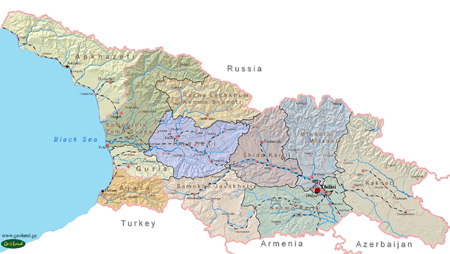General Information: Georgia is located east of the Black Sea and south of the Great Caucasus Mountain Range, between 41o-43 o north and 40o-46 o east. This region is currently known as the “South Caucasus” or “Trans-Caucasus” in Western languages. It shares borders with the Russian Federation in the north, Turkey and Armenia in the south and Azerbaijan in the east.

Territory: 69.700 sq. km
Government: Republic
Model of State: Presidential
Language: Official Georgian spoken language has many dialects, usually divided into East Georgian and West Georgian groups. These, together with the related Megrelian, Laz (Chan), and Svan languages, make up the Kartvelian or South Caucasian language family. Georgian is also spoken in parts of Azerbaijan, northeastern Turkey and in many villages in the region of Eṣfahān in Iran.
Population: 5,399,000 (1999), 56% residential, 44% rural
Ethnic Structure: Georgians – 70%, Armenians – 8%, Azeris – 6%, Russians – 5%, Greeks – 2%, other – 9%
Capital: Tbilisi, population – 1,700 000
Principal Cities: Kutaisi – (233,100), Rustavi- (150,000), Batumi- (130,100), Gori – (68,000), Poti – (50,900).
Banking 
Currency: Georgian National currency is Lari (GEL). All payments are made in Lari on the territory of Georgia. Among foreign currencies USD, EUR, and Russian Ruble are widely used. Cash is the preferred method of payment and visitors are advised to carry notes in small denominations.
Unit 1 Lari = 100 Tetri
Coins 1, 2, 5, 10, 20, 50 tetri
Bank-notes 1 , 2 , 5 , 10 , 20 , 50 , 100 , 500 Lari
Currency exchange: US Dollars, Euros and Rubles can be exchanged at special points throughout the city streets. Other currencies can be exchanged at the banks.
Credit & debit cards: Credit cards are accepted in major hotels, restaurants, shops and all the banks in Tbilisi.
ATM machines: are available in the cities.
Traveler’s cheques: US Dollars or Euros are recommended.
Currency restrictions: The import and export of local currency is unrestricted. The import of foreign currency is permitted. Georgian banks are integrated in the systems of SWIFT and WESTERN UNION.
Banking hours: Monday to Friday from 09:30 to 17:30.
Time zone: GMT + 3.
Electricity: 220 volts AC, 50 Hz. European-type, two-pin plugs are used.
Telephone: IDD is available.
Country code: 995. Outgoing international codes: 8-07 or 8-10, 8-18.
Mobile telephone: GSM 900 and 1800 networks. Main operators include Geocell Ltd (www.geocell.com.ge) and Magti Com (www.magtigsm.com). Coverage extends nearly all over the country, except a few lowland areas and some high mountain regions.
Airports: International Airport in Tbilisi – 20 km from Tbilisi center; International Airport in Batumi – 12 km from Batumi center.
Religion: Christian majority, mainly Greek Orthodoxy, other confessional groups include Shiite and Sunni Muslims, Armenian Gregorian, Catholics, Baptists, Judaists.
Geography 
Geography: Georgia is a mountainous country bordered by the Black Sea in the west, which forms a 315 km (205 mile) long coastline. The state is crossed by the ranges of the Greater Caucasus (highest peaks: Mt. Shkhara 5068m, Mt. Kazbek 5047m /16,554ft). The inter mountain depression to the south of the Greater Caucasus encompasses the Kolkheti lowlands, Inner Kartli, Lower Kartli and the Alazani Plains. Further south the Minor Caucasian ranges (Meskheti, Shavsheti and other ranges), reach 2850 m. The southernmost area of the country is covered by the volcanic South Georgian Uplands (Mt. Didi Abuli, 3301 m, its highest peak). The Greater Caucasus and the South Georgian Uplands are joined by the Likhi Range, which also divides Georgia into two contrasting climate zones: Western and Eastern. Sheltered high valleys, wide river basins, health spas with famous mineral waters, caves and waterfalls create a land of varied landscapes and striking beauty.
Climate 
Climate: There is quite a wide range of climate in Georgia, from the warm, humid, subtropical Black Sea coast, to the colder wet alpine climate of the High Caucasus and the arid steppes of the east. The Greater Caucasus and the South Georgian Upland join with the Likhi Range dividing Georgia into the two contrasting climate zones mentioned above: Western and Eastern Georgia. The Greater Caucasus mountain range moderates local climate by serving as a barrier against cold air from the north. Temperatures in the mountains range from an average of 5.7 oC to ?? In high mountains the winter lasts for eight months, with an average temperature of -15oC. It gets even colder on the high Javakheti plateau. On the cost of Adjara, temperatures range from 5.8 oC in January to 23.8 oC in August. In eastern Georgia temperatures range from 0.5 oC in January to 23 oC in August. Kakheti in East Georgia is considerably warmer and in summer, the temperature varies from + 30 to +40 oC, in winter -8 to +5 oC. The ideal visiting time for travelers would be from late spring till early fall for most tours, July and August for the seacoast and of course, winter for the snow resorts in the Caucasus Mountains.
Public Holidays
January 1 – New Year’s Day;
January 7 – Orthodox Christmas;
January 19 – Epiphany;
March 3 – Mother’s Day;
April 9 – Memorial Day;
May 5-6 – Orthodox Easter
May 26 – Independence Day;
August 24 – Constitution Day;
August 28 – Mariamoba (Assumption);
October 14 – Svetitskhovloba;
November 23 – Giorgoba (St. George’s Day).




